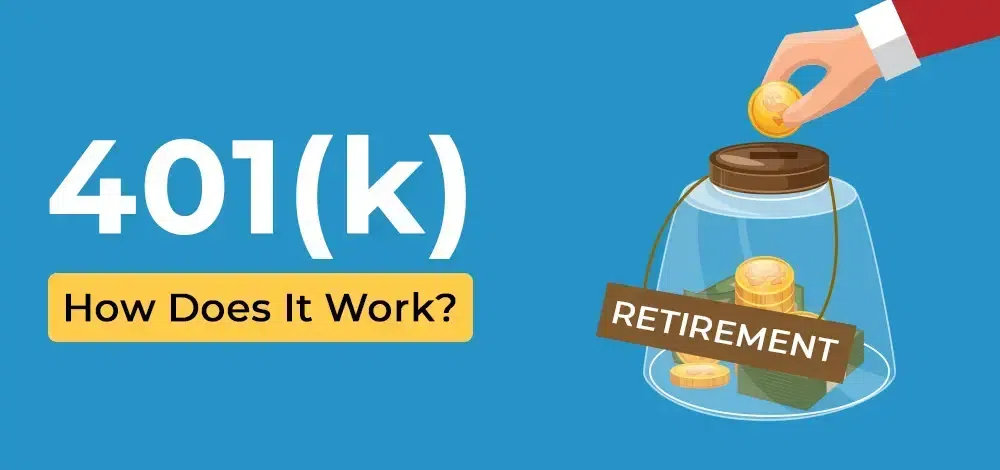If you’ve ever wondered how to save effortlessly for your future while working, we have the answer for you. By taking advantage of your employer’s enticing 401(k) plan, you can conveniently stash away a portion of your hard-earned money. It’s a win-win situation that not only helps you secure a comfortable retirement but also makes your employer more attractive to potential team members like yourself.
Whether you’re already employed or on the hunt for a new job, understanding the intricacies of your current or potential employer’s 401(k) plan is crucial. By familiarizing yourself with the plan’s unique features and benefits, you’ll be equipped to make informed decisions that align with your retirement goals.
Allow us to guide you through the ins and outs of a 401(k) plan and how it works. So let’s get right into it.
What is a 401(k) plan?
Simply put, a 401(k) plan is a company sponsored retirement plan that not only offer tax benefits but also offer some advantages while thinking about the future. It is a remarkable account that empowers you to set aside a portion of your hard-earned paycheck for retirement. While not obligatory, many employers generously offer their employees 401(k) plans, ensuring a reliable income stream during their golden years.
Some companies even extend this incredible opportunity to new hires right from the start, while others have a brief waiting period before inviting team members to join the 401(k) club. To learn more about your company’s specific policies regarding this fantastic benefit, you can refer to your employee handbook or reach out to a friendly human resources representative.
Did you know that you don’t necessarily have to open a 401(k) account with your employer, even if they provide one? However, if you decide to seize this incredible opportunity, your employer will automatically deduct your chosen contribution from your paycheck and neatly deposit it into your very own 401(k) account.
While your employer might also contribute to your account (though they’re not obliged to), the magic of investments truly sets this plan apart.
You have the power to choose from a range of investment options carefully curated by your employer or other financial institutions participating in the plan. These investment options can include mutual funds, stocks, bonds, and money market accounts. Of course, the choices available may vary depending on what your employer offers.
But fear not; even with limited options, a 401(k) plan can cater to different types of savers and help you achieve your retirement goals, given that the funds in your 401(k) grow tax-deferred.
That means you won’t have to worry about paying income taxes on the capital gains, dividends, or interest earned within your account until you withdraw them. It’s like giving your money the VIP treatment, allowing it to grow faster without pesky taxes slowing it down.
However, it’s important to note that if you withdraw funds from your 401(k) before reaching the age of 59.5, you may be subject to ordinary income tax and a 10% early withdrawal penalty unless you qualify for an exemption. So, it’s best to keep those retirement funds tucked away until the right time comes.
How Do 401(k) Plan Works
Employer Matching
Employers have the option to match their employees’ contributions to qualified plans. They can choose the amount, percentage, and timing of these matching contributions. Employers also have the flexibility to update their plans as needed.
The employer’s contributions to an employee’s 401(k) plan can be in the form of a fixed dollar amount, a percentage of the employee’s salary, or a percentage of the employee’s contribution.
For example, if an employee earns $50,000 annually and contributes 10% (or $5,000) to their qualified plan through the employer match program, the employer would also contribute $5,000.
Employer matching is a common feature of 401(k) savings plans. It allows employees to delay paying taxes on their earnings until they withdraw funds after retiring.
Withdrawal Options
Typically, you cannot withdraw funds from your 401(k) account while still working and under 59 ½ years old. However, there are circumstances where you may be eligible for a hardship withdrawal. These include:
Postsecondary tuition for you or your family
- Medical or funeral expenses for you or your family
- Specific costs related to purchasing or repairing your primary residence
- Preventing immediate eviction or foreclosure of your primary residence
Hardship withdrawals from pre-tax contributions and earnings are generally subject to taxes and may incur a 10% early withdrawal penalty. These distributions cannot be rolled over to an Individual Retirement Account (IRA).
Required Minimum Distributions
The IRS mandates that all 401(k) plan holders start taking withdrawals from their accounts once they reach 73 years old. This is known as a required minimum distribution (RMD).
Failure to comply with the distribution requirements may result in severe penalties imposed by the IRS.
The purpose of required minimum distributions is to prevent individuals from keeping money in their 401(k) plans until they pass away, thereby shifting the tax burden to their beneficiaries.
Types of 401(k) Plans
Traditional 401(k):
A traditional 401(k) is a smart way to save for retirement while enjoying tax benefits. It allows you to set aside a portion of your income before taxes are calculated. Plus, your employer may even match your contributions up to a certain limit. The money you invest is then directed towards mutual funds and other investments, growing over time. However, when you withdraw funds during retirement, you’ll be subject to ordinary income tax.
Roth 401(k):
Another option to consider is the Roth 401(k). With this approach, you contribute to your retirement savings using after-tax income. The exciting part is that you won’t owe any income taxes on qualified distributions, including those made after you reach the age of 59 ½, provided that your first contribution was made at least five years prior. If you anticipate being in a higher tax bracket when you retire, a Roth 401(k) can be a wise choice, especially for young professionals starting their careers at lower income levels.
Can I Have Both?
Absolutely! You’re not limited to choosing just one type of 401(k) plan. If your employer offers both options, you can contribute to both a traditional and a Roth 401(k). Balancing your contributions between the two or seeking guidance from a tax professional or financial advisor can help you make the best decision for your unique situation.
401(k) changes
With inflation on the rise, the maximum amount you can contribute annually to your 401(k) plans has increased.
In 2022, the limit was $20,500, but now, in 2023, you can contribute up to $22,500. If you’re 50 years or older, the new limit is even more impressive, reaching $30,000 compared to $27,000 last year.
But wait, there’s more! If you haven’t started participating in your company’s 401(k) plan yet, listen up. A new spending bill, signed by President Biden, will make it mandatory for employers to automatically enroll eligible employees in 401(k) and 403(b) plans starting in 2025.
Under this legislation, your automatic contribution will begin at a minimum of 3% of your paycheck, ensuring you start saving for retirement right away. As an added benefit, your contributions will increase by 1% each year until you reach an annual contribution of at least 10%, capped at a maximum of 15%. It’s a hassle-free way to secure your financial future!
Rest assured, if you’re already enrolled in a 401(k) or 403(b) plan, the new legislation won’t impact your existing plan. All current plans are grandfathered and will continue as before.
What Happens to Your 401(k) When You Change Jobs?
When changing jobs, it’s important to consider your options for your 401(k) balance. Avoid the mistake of cashing out your savings, as this can result in a 10 percent early withdrawal tax penalty if you’re under 59½ years old. If it’s a traditional 401(k), you’ll also have to pay income tax on the balance.
If your 401(k) balance is less than $1,000, the plan administrator has the authority to issue you a check for the balance. You then have a 60-day window to reinvest the money in an IRA or your new company’s 401(k) plan before being subject to the additional 10% tax penalty and possible ordinary income tax.
For balances between $1,000 and $5,000, the administrator can open an IRA in your name and transfer your balance into it. This provides a convenient option for managing your retirement funds.
While some 401(k) plans allow you to leave your money where it is after leaving the company, it’s important to note that this approach may result in multiple 401(k) accounts to keep track of as you progress in your career.
Conclusion
Saving up for retirement can be tough, especially if you put it off. But by enrolling in a 401(k) plan, you not only take advantage of tax breaks but also benefit from compounded interest. That means your money can grow faster and more efficiently, giving you a head start on your retirement goals.
It’s a win-win situation. So start building your retirement savings without delay!
FAQs on 401(K) Plans
Q1. Do we have 401k in India?
Answer: No, India does not have a specific retirement savings plan called a 401k. The concept of a 401k is primarily associated with the United States. However, India has its own retirement savings options such as the National Pension Scheme (NPS) and the Employee Provident Fund (EPF).
Q2. Is 401k taxable in India?
Answer: Since 401k is not applicable in India, there is no specific taxation related to it. However, it’s important to note that any income earned through investment or savings schemes in India may be subject to taxation as per the relevant income tax laws and regulations.
Q3. How Do You Start a 401(k)?
Answer: To start a 401(k) plan, you typically need to follow these steps in the United States:
- Check with your employer: Confirm if your employer offers a 401(k) plan and learn about the eligibility criteria.
- Enrollment: If eligible, complete the enrollment process by filling out the necessary paperwork provided by your employer.
- Contribution selection: Decide on the contribution amount or percentage you wish to allocate from your pre-tax salary to your 401(k) account.
- Investment options: Choose the investment options available within your employer’s 401(k) plan based on your risk tolerance and retirement goals.
- Beneficiary designation: Designate beneficiaries who will receive the funds in your 401(k) account in the event of your death.
- Manage contributions: Monitor your contributions regularly and make adjustments if necessary.
It’s important to note that the process may vary depending on the specific policies and guidelines of your employer’s 401(k) plan.
Q4. What are the 401k contribution limits for 2023?
Answer: For the year 2023, the contribution limit for employees participating in a 401(k) plan is set at $22,500. However, if you are aged 50 or older, you have the opportunity to make catch-up contributions, raising the limit to $30,000. It’s important to note that these limits reflect a modest increase from the previous year.
In 2022, the individual 401(k) contribution limit was $20,500 for employees, and $27,000 for those who were 50 or older. Please bear in mind that these figures are based on the information available up until my knowledge cutoff in September 2021. For the most accurate and up-to-date information, it is advisable to consult the official guidelines from the Internal Revenue Service (IRS) or seek advice from a financial professional.





